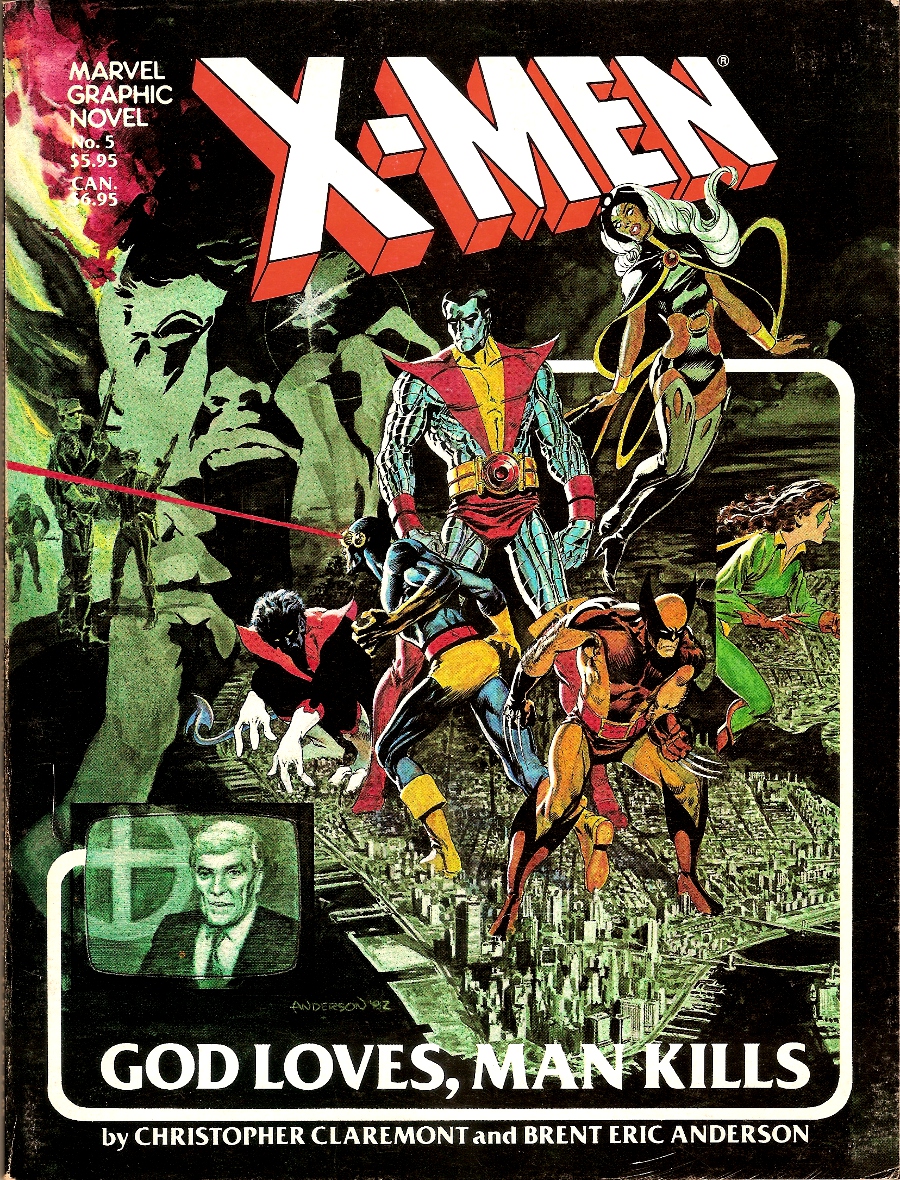 Over on Super Movie Mondays, we’re currently in the middle of a three-part look at X2, Bryan Singer’s sequel to his X-Men, which kicked off the current superhero movie boom. And as I mentioned on Tuesday, X2 was based in part on a Marvel Graphic Novel titled God Loves, Man Kills, published in 1982.
Over on Super Movie Mondays, we’re currently in the middle of a three-part look at X2, Bryan Singer’s sequel to his X-Men, which kicked off the current superhero movie boom. And as I mentioned on Tuesday, X2 was based in part on a Marvel Graphic Novel titled God Loves, Man Kills, published in 1982.
The reason I capitalized Graphic Novel was that that was the name of the series. Marvel put out a bunch of them in the early 80’s. They weren’t very novelistic: only 64 pages, comparable to a Giant-Size Annual. But they were square-bound (hence the blurry scanning) on nice paper with better printing and colors (in theory–my copy of God Loves… has two pages so smeared that they are unreadable), and not being newsstand comics bearing the Comics Code seal, they could include more adult subject matter.
Like, say, the lynching of two black kids. The story opens with a young brother and sister fleeing through the night. They stop to rest in a playground and are caught by the men pursuing them. The woman leading the group calls herself a Purifier and shoots the kids dead, but not before one of them begins to exhibit a mutant power. She has her men hang the kids’ bodies from the swing-set with a sign reading “Muties.”
But before the locals can discover the dead kids, Magneto finds them and swears vengeance on their killers. Meanwhile, in New York City, famed televangelist William Stryker is receiving a briefing on the X-Men, whom he has dire plans for.
Speaking of the X-Men, Kitty Pryde is fighting with a human student at Stevie Hunter’s dance studio. He and his family are big fans of the Stryker crusade, which preaches that mutants are not only a threat to mankind, but are not even truly human. Peter Rasputin and his sister Illyana break up the fight, and Claremont gets the chance to show us this isn’t the monthly comic.
Ooh, controversial language! But it’s actually a good question, and a rare moment (perhaps the only one in the entire book) where Claremont doesn’t pound the point into the ground like John Henry driving steel against the Inky-Poo.
That night, Professor X appears on television to debate Stryker, and it goes about as well as you’d expect.
A couple of things to notice here. One, Â Stryker’s little “Now there you go, Charles” comment. It may seem like a perfectly innocent dismissive line, but this was 1982, during Reagan’s first term in office, and Reagan’s most memorable moment in his debates with Jimmy Carter during the campaign was to disarm one of Carter’s arguments with the line, “There you go again.”
So now the story has taken on a distinct political flavor, which is furthered by the control room personnel. One man says that Stryker’s rhetoric is “pretty damn scary,” but that he’s winning the debate because he knows how to work the camera, once again echoing what was the common wisdom of the time: that Reagan used his folksy charm and experience as an actor to mask his evil right-wing agenda.
Second, notice the mention of Senator Robert Kelly, who was a major character in the first X-Men movie.
After the debate, the assembled X-Men at home–Colossus, Wolverine, Nightcrawler and Kitty (who at the time was using the code-name Ariel)–have a Danger Room workout so we can see their powers in action. Meanwhile, Professor X, traveling back to the mansion with Cyclops and Storm, has his limo attacked by Purifiers. They shoot Cyclops and Storm and capture the professor.
Back at the mansion, the X-Men are shocked to hear that the three have died in a car crash. But the next morning, Wolverine, Colossus and Nightcrawler go to the crash site, where Wolverine pronounces the entire thing a hoax. Their friends have been kidnapped, not killed.
Further investigation leads them to a car full of Purifiers. They attack, but the Purifiers have powered armor which can take down even Colossus. However, before the fight can turn truly ugly, Magneto intervenes and proposes that he and the X-Men work together.
Back at the mansion, Kitty and Illyana have stumbled upon a monitoring device aimed at the mansion and gotten kidnapped by more Purifiers.
Oh hey, remember in the first part of my X-Men recap when I said this moment…
…had been inspired by something that I thought was in the John Byrne run of issues I had sold off? Turns out I was wrong. It’s in here!
The guy doesn’t talk, so Magneto steps in and tortures the information out of him. Nightcrawler offers a token, “How are we any better than them?” AFTER the torture, but they ignore him. George W. Bush was still 20 years away from putting the Republican taint on it, so it’s pretty much depicted as a necessary tactic in order for our heroes to succeed. Remember, kids, enhanced interrogation is only bad when Republicans do it.
Hey, we’re finally back to Professor X, being tortured and brainwashed into thinking mutants are evil. I don’t find it exactly believable, which is bad when this is THE CENTRAL PILLAR of the bad guy’s plan, but there is a clever twist in that part of Xavier’s torture involves torturing Cyclops and Storm, which Xavier feels telepathically. He feels the pain coming from them, and his subconscious associates them with the pain.
This is followed by the world’s dumbest origin story. Stryker was an Army Ranger who was involved in nuclear tests in the desert. Later, he and his pregnant wife suffered a car crash in the desert, which apparently caused her to go into labor. The child was a deformed mutant, which so horrified Stryker that he killed both the baby and his wife, then blew up the car. He survived and turned to God for answers about his bad luck, eventually coming to blame mutants. He orders the Purifiers to kill Kitty and has a brainwashed Professor X psychically kill Cyclops and Storm to prove he is ready for the final phase of the plan.
But Kitty  manages to escape her captors by leading head Purifier Anne onto gang turf and slipping away while Anne fights off a bunch of gang-bangers. More Purifiers catch up to her on an elevated train, but Magneto and the X-Men show up to rescue her. They pursue a few more clues and rescue a not-all-the-way-dead Cyclops and Storm, and now everything is set for the final confrontation.
Well, after Magneto gives a monologue about his ideal world: “Contentment breeds tranquility–discontent, rebellion. Therefore I shall ensure the one by eliminating the root causes of the other: hunger, poverty, disease, war. The freedoms lost will not be noticed, even in the most libertarian of states, and the material benefits should more than balance the scales.” Cut out the big words and throw in a couple of “let me be clear’s,” and it could be an Obama speech.
Meanwhile, Stryker’s plan is pretty simple: Professor X will use a modified version of Cerebro that Stryker has built to find and kill every mutant in the world with his incredible telepathic powers.
Not sure exactly what the giant televised rally has to do with it, but whatever. And once again, Claremont gives Stryker’s villainous plot a political twist by having an aide tell Senator Kelly that the President is “a fair-minded man” who “believes the Reverend’s views deserve a hearing.” The rally begins and the mutant death wave is launched.
While the X-Men fight to free Xavier from the Faux-rebro pod, Magneto confronts Stryker and gets knocked down by Xavier’s enhanced power. Meanwhile, other mutants are beginning to suffer the effect of Xavier’s mental attack, including Senator Robert Kelly and Stryker’s head Purifier, Anne. Ooh, irony.
Now you’d expect the story to end there. Charles has been saved and Stryker’s career is over after he murders a woman on live national television. But Claremont has apparently decided the horse isn’t quite dead yet, so he has the X-Men appear on stage to confront Stryker, who has somehow not been arrested yet. And after a vigorous debate on the issues, Stryker pulls a pistol and prepares to shoot Kitty in full view of the crowd and the cameras, when a cop FINALLY decides enough is enough and shoots him.
So in broad outlines (and yes, I’m spoiling the spoiler-filled posts about the movie I’ll be doing later), the story bears similarities to the movie–bad guy named Stryker plans to use a modified Cerebro and a brainwashed Professor X to kill all the mutants in the world, and the X-Men must team up with Magneto to stop him.
But the world has changed since the story was first written. High-profile televangelists don’t hold as much sway or political influence as Jerry Falwell and Pat Robertson did back in the day, so the filmmakers wisely decided to ditch that angle.

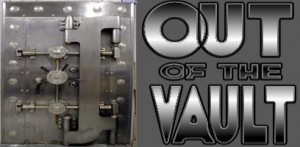
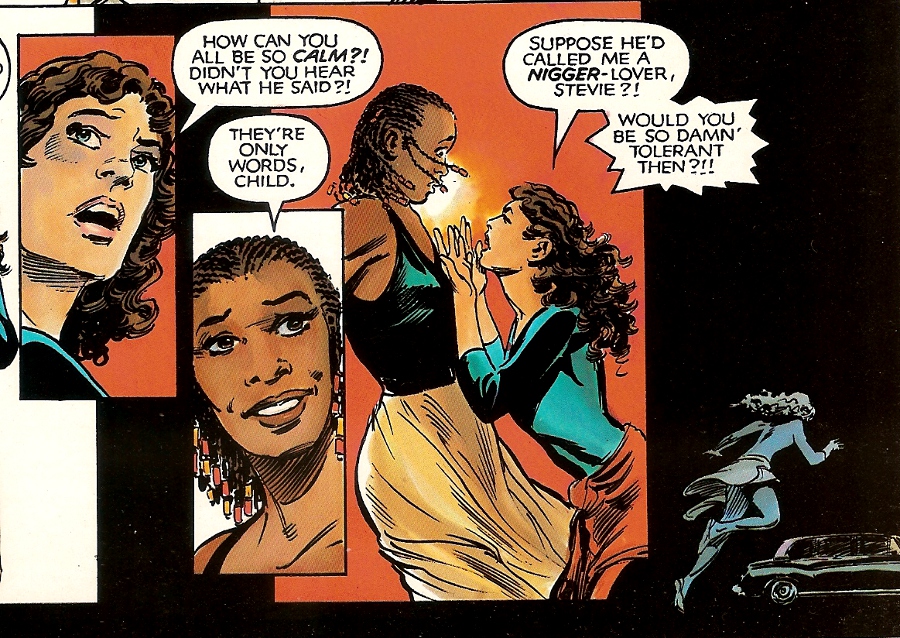
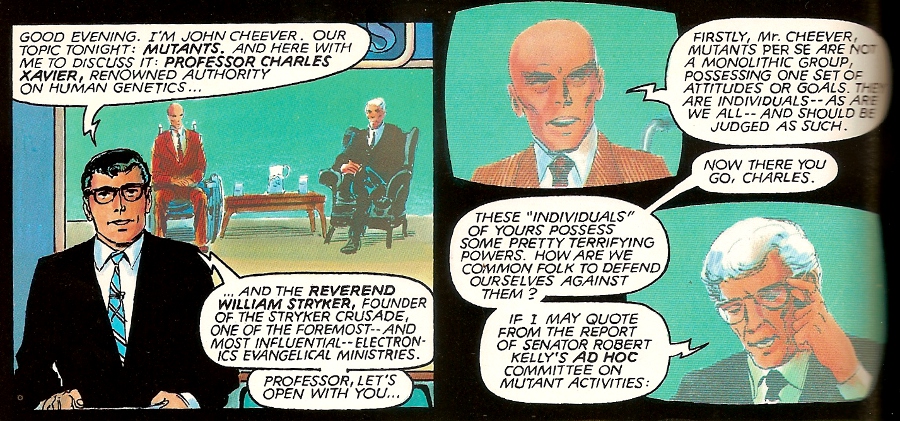
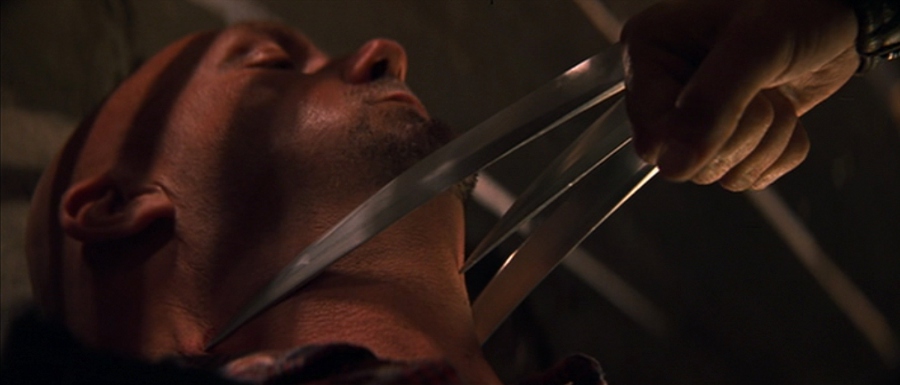
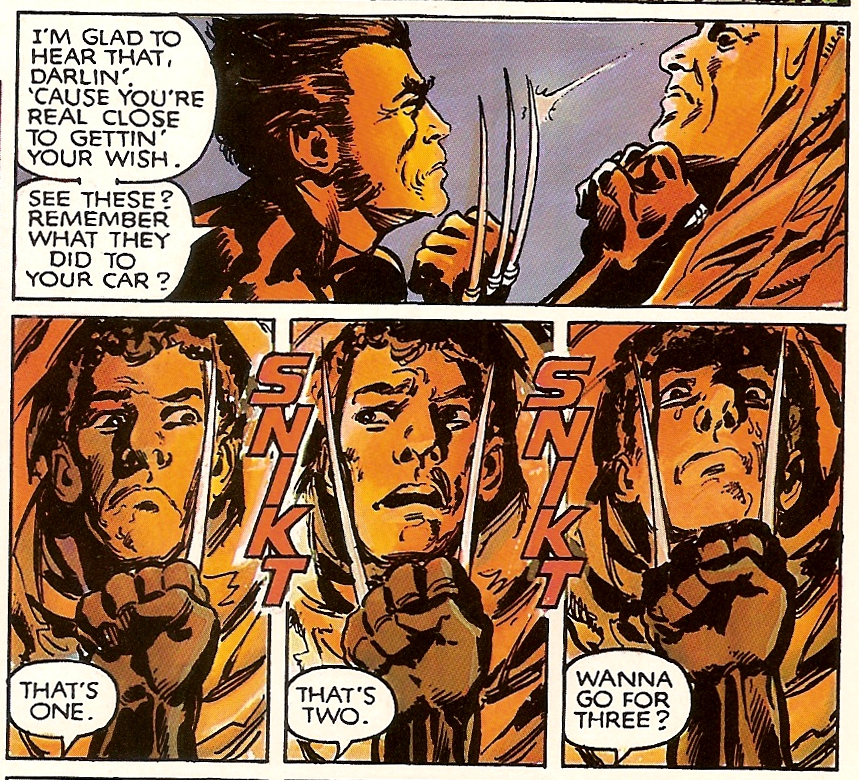
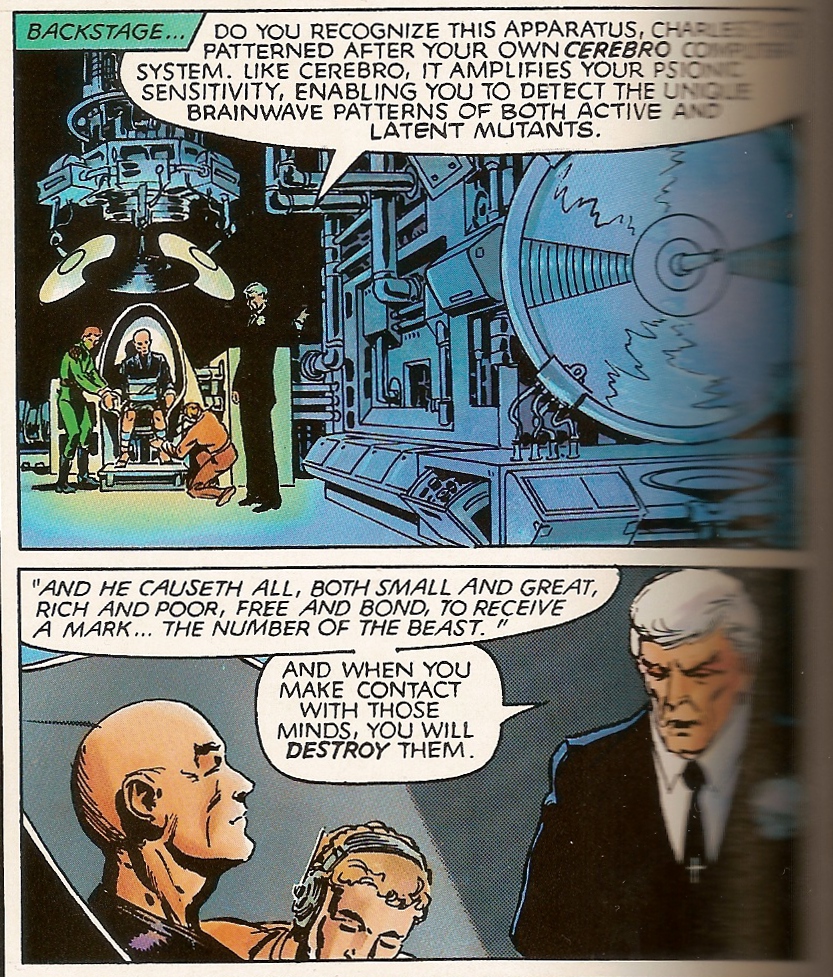
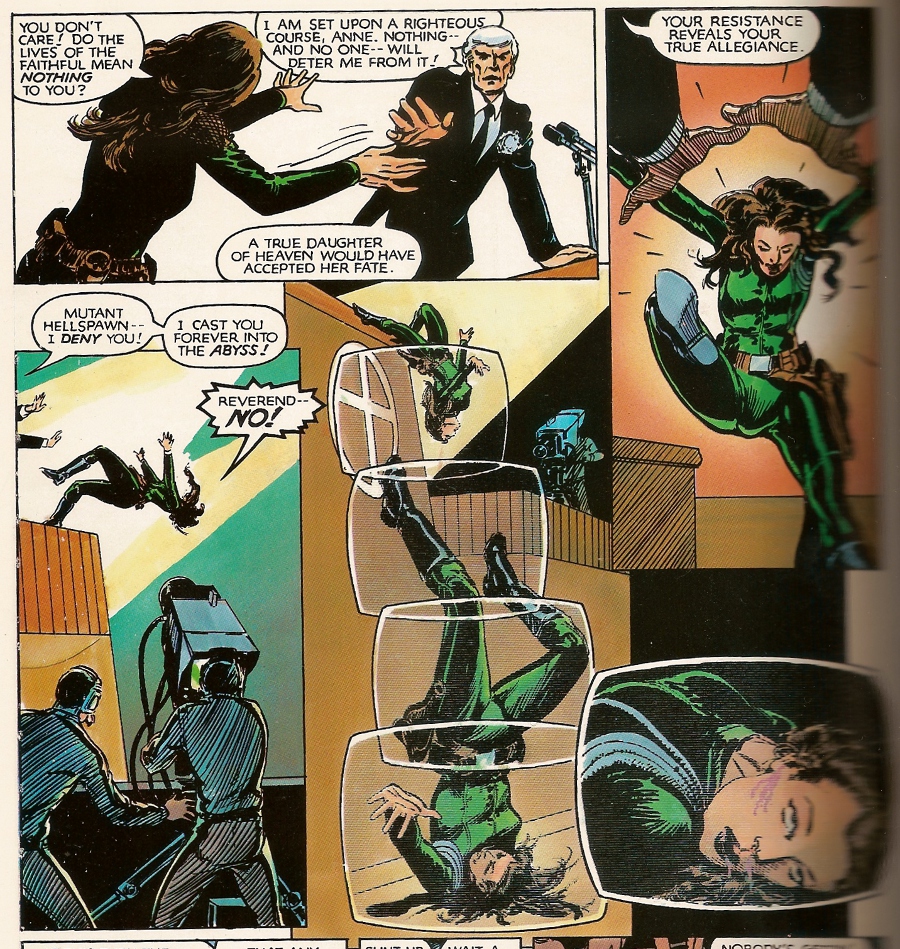



I’m always interested in how torture is used in narratives, because studies have shown that it doesn’t really work – it won’t make a person tell the truth, but rather what they think you want to hear – but it is a staple of books and movies for good guys and bad guys, probably because it moves the story along quicker. But such a place in fiction just helps further legitimize it in the popular mind.